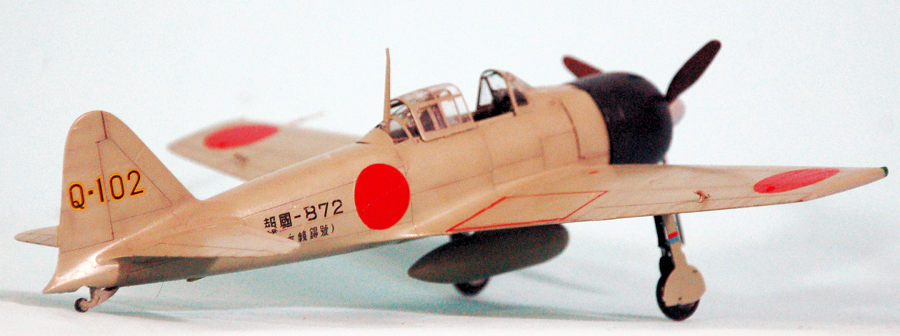
| KIT #: | 09181 |
| PRICE: | $24.95 'used' |
| DECALS: | Three options |
| REVIEWER: | Tom Cleaver |
| NOTES: | 1997 Limited Edition |

| HISTORY |
The A6M2 Model 21 Zero revealed it was slightly underpowered when it entered combat in 1941. Mitsubishi answered this problem with the A6M3, powered by an uprated Sakae 21 engine, which used a two-speed supercharger for better altitude performance, and increased power to 1,130 hp. A prototype with the new engine was first flown on July 15, 1941. The new engine was slightly heavier and somewhat longer due to the larger supercharger, which moved the center of gravity too far forward on the existing airframe. To correct for this, the engine mountings were cut back by 7.3 inches, which reduced the size of the main fuselage fuel tank located between the engine and the cockpit from 137 gallons to 120 US gallons. The cowling was redesigned to enlarge the cowl flaps, revise the oil cooler air intake, and move the carburetor air intake above the engine in the upper half of the cowling.
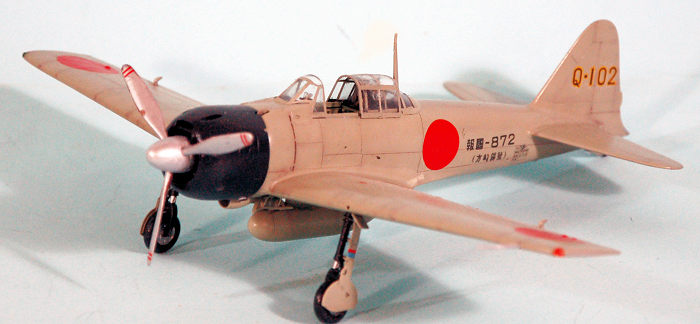 The Model
32 featured a redesigned wing with the folding tips removed, which squared off
the wingtips. The inboard edge of the aileron was moved outboard by one rib, and
the wing fuel tanks were enlarged to 110 gallons. The 20 mm cannons were
upgraded from the Type 99 Mark l to the Type 99 Mark II, while ammuntion
capacity was increased to 100 rpg.
The Model
32 featured a redesigned wing with the folding tips removed, which squared off
the wingtips. The inboard edge of the aileron was moved outboard by one rib, and
the wing fuel tanks were enlarged to 110 gallons. The 20 mm cannons were
upgraded from the Type 99 Mark l to the Type 99 Mark II, while ammuntion
capacity was increased to 100 rpg.
The changes increased maximum speed by only 6.8 mph compared to the Model 21, but reduced maximum range by approximately 620 miles. The shorter wing span led to better roll, while reduced drag allowed diving speed to be increased to 420 mph. Maneuverability suffered due to smaller ailerons and decreased lift, while range suffered due to greater fuel consumption. Nevertheless, the navy accepted the new type and it entered production in April 1942. Mitsubishi produced only 343 before it was replaced by the A6M3 Model 22, which restored the Model 21 wing and the maneuverability and nearly the range of the A6M2.
 The reduced
range proved a significant limitation during the Solomons Campaign, where Zeros
based at Rabaul had to fly nearly to their maximum range to reach Guadalcanal
and return. Thus, the Model 32 initially entered combat over New Guinea, where
it replaced the Model 21s of the Tainan Air Group based at Lae and Salamaua. The
lack of range spurred the Japanese to construct airfields on Bougainville, the
northernmost island of the Solomons chain, which allowed the Model 32 to be
widely used during the Central Solomons campaign that commenced after the U.S.
took control of Guadalcanal. The new type equipped the carrier air groups of the
ships at Truk, which were pressed into service at Rabaul and it saw extensive
combat during the Rabaul campaign between September 1943 and February 1944.
The reduced
range proved a significant limitation during the Solomons Campaign, where Zeros
based at Rabaul had to fly nearly to their maximum range to reach Guadalcanal
and return. Thus, the Model 32 initially entered combat over New Guinea, where
it replaced the Model 21s of the Tainan Air Group based at Lae and Salamaua. The
lack of range spurred the Japanese to construct airfields on Bougainville, the
northernmost island of the Solomons chain, which allowed the Model 32 to be
widely used during the Central Solomons campaign that commenced after the U.S.
took control of Guadalcanal. The new type equipped the carrier air groups of the
ships at Truk, which were pressed into service at Rabaul and it saw extensive
combat during the Rabaul campaign between September 1943 and February 1944.
The initial appearance of the redesigned A6M3 Model 32, which was initially thought to be a completely new type, prompted the USAAF to assign it a new code name, "Hap". The name was short-lived, as a protest from USAAF Commanding General Henry "Hap" Arnold forced a change to "Hamp". Soon after, it was realized it was simply a new model of the "Zeke" and was termed "Zeke 32".
| THE KIT |
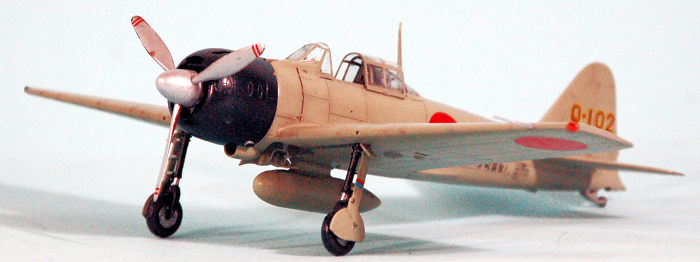 Hasegawa
has basically “owned” the Zero series since they first released an A6M5a that
was the last Mania kit before that company was acquired by Hasegawa in 1979 and
its designers transformed Hasegawa kits. The A6M3 was one of the “mid-range”
Zero kits released in the early 1990s, which included the Model 22 and an
improved A6M5a, which all improved the original Mania kit with engraved panel
lines and a cockpit with more detail.
Hasegawa
has basically “owned” the Zero series since they first released an A6M5a that
was the last Mania kit before that company was acquired by Hasegawa in 1979 and
its designers transformed Hasegawa kits. The A6M3 was one of the “mid-range”
Zero kits released in the early 1990s, which included the Model 22 and an
improved A6M5a, which all improved the original Mania kit with engraved panel
lines and a cockpit with more detail.
The “Houkoku” kit was a limted release in 1997 with decals for air groups from the Mobile Fleet that fought at Rabaul.
| CONSTRUCTION |
The Hasegawa Zero series benefit from excellent kit design, which provides improved fit in comparison with other kits released at this period before CAD design transformed things. If a modeler is careful when assembling the kit, it can be completed with a minimum of filler, mostly along the aft fuselage centerline.
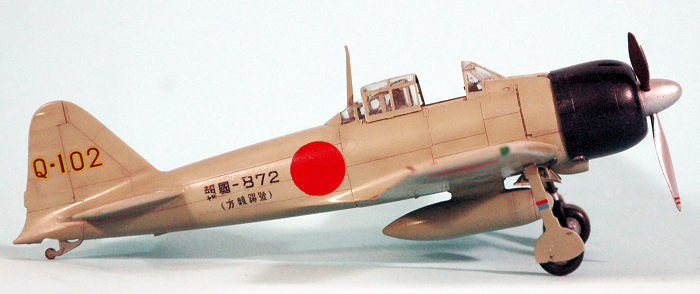 I began by
painting the parts for the cockpit with Tamiya “Cockpit Green,” which is
“Mitsubishi Green.” While that set up, I assembled the wing and fuselage, then
proceeded to assemble the cockpit and install it inside the fuselage. I painted
the engine with Tamiya Flat Aluminum and “popped” the detail using Tamiya
“Smoke” before sticking it in the cowling. I kept the engine and cowling
separate until I completed painting the model. I used Eduard IJN photoetch
seatbelts.
I began by
painting the parts for the cockpit with Tamiya “Cockpit Green,” which is
“Mitsubishi Green.” While that set up, I assembled the wing and fuselage, then
proceeded to assemble the cockpit and install it inside the fuselage. I painted
the engine with Tamiya Flat Aluminum and “popped” the detail using Tamiya
“Smoke” before sticking it in the cowling. I kept the engine and cowling
separate until I completed painting the model. I used Eduard IJN photoetch
seatbelts.
The wing and fuselage sub-assemblies fit easily, and I only needed some CA glue along the rear seam on the underside of the fuselage, which was sanded smooth and the panel lines rescribed. I finished by attaching the horizontal stabilizers.
| COLORS & MARKINGS |
As a
Mitsubishi-built airplane, the Model 32 was painted overall pale grey-green
known as “Ameiro.” Tamiya released a paint that is this color, XF-76 “Gray-Green
(IJN)” which I used. The engine cowling was a dark blue that closely
approximated USN Midnight Blue, and I used Xtracrylix “Midnight Blue” for that.
I used the kit decals to do “Q-102,” which was an airplane from the Zuikaku Air
Group flown at Rabaul in the fall of 1943. The Mitsubishi
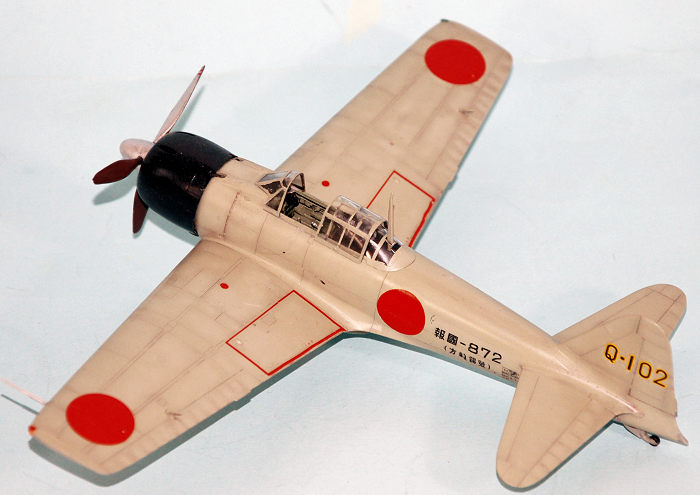 factory scheme
included painting the gear wells and inner sides of the gear doors in the
exterior color.
factory scheme
included painting the gear wells and inner sides of the gear doors in the
exterior color.
Most of us over the years have finished our Zero models with flat heavily-worn finishes, based on photographs of wrecks seen on South Pacific airfields, which were taken after the fields were overrun by the Allies, by which time those wrecks had sat there for anything from six months to a year, lots of time for sun-fading.
However, recent research says that the early-model Zeros were painted with a glossy paint with good priming, which stood up well when used on carriers and was resistant to weathering. While researching my coming book “Under The Southern Cross: The Allied Air Campaign Against Rabaul,” I found numerous US pilot combat reports that stated the Zeke that pilot had shot down was “new and shiny.” My research further revealed that the carrier air groups which were fed into the Rabaul meat grinder in 1943 only lasted some 3-6 weeks before their losses were such they were replaced. That is not enough time - even at Rabaul - for an airplane to become sun-faded with a flat finish, which explains the pilot reports of “new, shiny” opponents. Thus, after I gave my model a coat of Micro “Satin,” I did not weather it further.
I attached the landing gear and prop, and unmasked the canopy, which I attached in the open position.
| CONCLUSIONS |
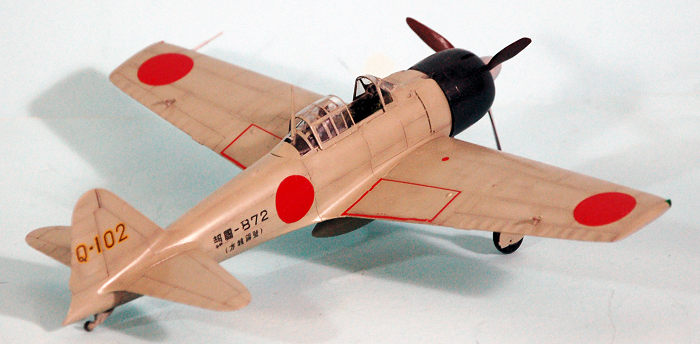 The
Hasegawa Zeros are still excellent kits, and are available on eBay and other
locations at attractive prices. If you want a Zero other than the A6M3 Model 21
and A6M5a (the only two that Tamiya now does), and you want a model with a
nicely-detailed cockpit and canopy that can be posed open, the Hasegawa series
of kits is what you want. Any modeler who has built a few kits, and who commits
to care in assembly, is pretty much guaranteed a very nice result. Highly
recommended.
The
Hasegawa Zeros are still excellent kits, and are available on eBay and other
locations at attractive prices. If you want a Zero other than the A6M3 Model 21
and A6M5a (the only two that Tamiya now does), and you want a model with a
nicely-detailed cockpit and canopy that can be posed open, the Hasegawa series
of kits is what you want. Any modeler who has built a few kits, and who commits
to care in assembly, is pretty much guaranteed a very nice result. Highly
recommended.
26 September 2019
Copyright ModelingMadness.com Review kit
courtesy of the modeler who didn’t purchase A Round Tuit and thus never built
it. If you would like your product reviewed fairly and fairly quickly, please
contact
the editor or see other details in the
Note to
Contributors.
Back to the Main Page
Back to the Review
Index Page
Back to the Previews Index Page